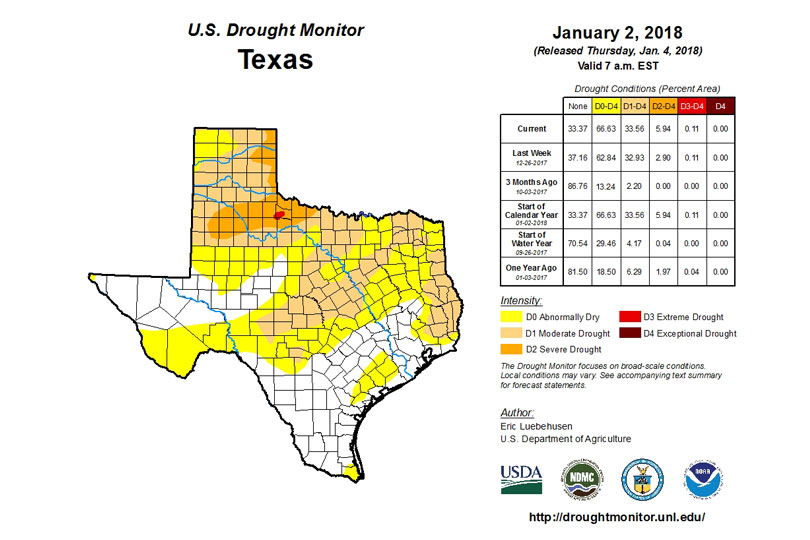By Justin Walker
Communications Specialist
Drought conditions are improving in Northeast Texas and the Coastal Bend, but spreading in the Panhandle, according to the latest Texas Water Development Board’s weekly water report.
The report shows 33 percent of the state is suffering from some type of drought conditions compared to 37 percent one week ago. Three months ago, only four percent of the state was facing drought conditions.
The extreme drought conditions seen in the far northeastern portion of the state were downgraded to either moderate drought or abnormally dry.
The Coastal Bend and South Texas have seen conditions improve overall.
The Panhandle had isolated areas of moderate drought in mid-December, with a small area of severe drought in Foard County. That severe rating has elevated to extreme, with a rather large severe drought rating covering the rest of Foard and adjacent counties. A majority of counties in the region are now under moderate conditions.
The seasonal drought outlook suggests these patterns could continue for the next several months.
Northeast Texas is expected to see more improvements, but drought will remain in the region.
Central East Texas is likely to see drought conditions removed while the western half of the state, however, will have drought conditions persist or continue to develop, according to the National Oceanic and Atmospheric Administration.
Following a frigid beginning to 2018, the National Weather Service (NWS) in Fort Worth is predicting below normal precipitation in January across Texas and above normal temperatures later in the month.
“We started 2018 on a cold note,” Matt Bishop, meteorologist with the NWS in Fort Worth, told the TFB Radio Network. “We’re still struggling with rainfall. From a climatological perspective, it looks like we’re going to be below normal on our rainfall. We have a higher chance than normal of being below average on our rainfall with temperatures actually moderating and becoming above normal as well for the early part of this year.”
“The chances are, in this type of pattern, we will be wanting the rain and not getting as much as we really need,” Bishop said. “When you look at these arctic outbreaks and this type of a La Nina climatological pattern that we’re in, we are typically above normal on temperatures. But that leaves the area open and susceptible to short periods of very cold arctic outbreaks, which is what we had. So this is kind of typical for a La Nina type of winter.”
Hear more from Bishop on the TFB Radio Network.

